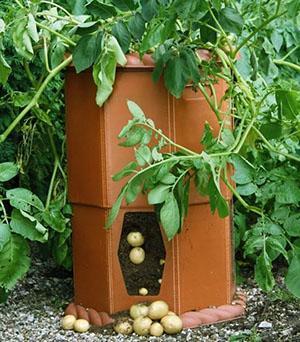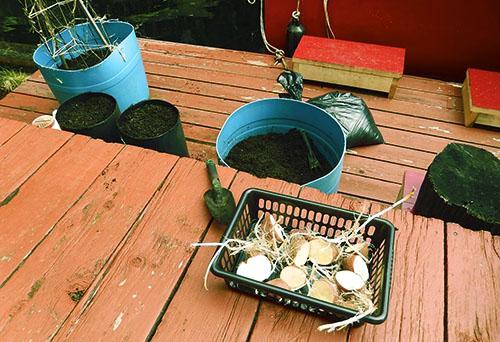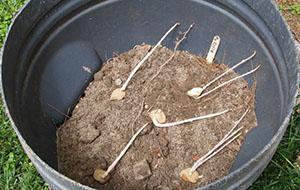Growing potatoes in a barrel - features of planting, feeding and care
 Unusual ways of growing potatoes, for example in bags, high ridges or under straw, have recently become widely known to domestic gardeners. But if you think about it, many in their own plot watched how a tuber that got into a container with compost gave not only friendly shoots, but also tubers. In a well-warmed, nutritious and necessarily humid environment, the culture yields a crop even in a limited amount.
Unusual ways of growing potatoes, for example in bags, high ridges or under straw, have recently become widely known to domestic gardeners. But if you think about it, many in their own plot watched how a tuber that got into a container with compost gave not only friendly shoots, but also tubers. In a well-warmed, nutritious and necessarily humid environment, the culture yields a crop even in a limited amount.
In fact, this principle is based on method of planting potatoes into barrels and other similar containers that may not be metal, plastic, or wood. The main condition is that the barrel is higher than 30 cm, moisture and oxygen are supplied to the roots in abundance, and the soil is loose and nutritious.
Preparing for planting potatoes

This technique will help to leave excess moisture, and oxygen to penetrate to the roots of plants. In the case of potatoes, this is doubly important, since the root system is not so large, and the load on it is colossal.
The technology of growing potatoes in a barrel implies that the amount of planting material, and then the tubers formed in the container, is quite large. So that the gardener can control the delivery of moisture and oxygen:
- a perforated hose or a plastic pipe with cuts at a distance of up to 20 cm from each other is vertically inserted into a high barrel.
- the open end, through which, after planting is complete, it will be possible to water, feed the potato plantation, is taken out.
If a compressor or pump is connected to the hole, it is easy to saturate the soil in the barrel with oxygen. A root drip irrigation system will help to evenly moisturize the soil under the potatoes.
Planting potatoes in a barrel and caring for the plantation
 Potatoes in a barrel cannot do without a safe, nutritious potting soil mixture. For this culture, a soil consisting of equal parts of the finished compost or rotted humus and ordinary garden soil.
Potatoes in a barrel cannot do without a safe, nutritious potting soil mixture. For this culture, a soil consisting of equal parts of the finished compost or rotted humus and ordinary garden soil.
Since plants are to be grown in a practically closed small volume, it is important that pests dangerous for potatoes do not appear in the barrel along with the soil. Therefore, soil for neutralizing insects and their larvae:
- pre-calcined or steamed;
- even in the fall, before planting, they are etched with chemicals.
 In the fall, when the soil for growing potatoes in a barrel is just being prepared, a mixture of ammonium nitrate or urea, double superphosphate, potassium compounds and ash is added to it. Magnesium sulphate and dolomite flour are added to sandy soils that are deficient in magnesium. Then the barrel is installed in the place intended for it and the soil is poured onto the bottom with a layer of 10 to 15 cm. Seed germinated tubers or pieces with hatched eyes are laid on the ground, pressing a little, and the potatoes are covered with ten centimeters of soil mixture on top.
In the fall, when the soil for growing potatoes in a barrel is just being prepared, a mixture of ammonium nitrate or urea, double superphosphate, potassium compounds and ash is added to it. Magnesium sulphate and dolomite flour are added to sandy soils that are deficient in magnesium. Then the barrel is installed in the place intended for it and the soil is poured onto the bottom with a layer of 10 to 15 cm. Seed germinated tubers or pieces with hatched eyes are laid on the ground, pressing a little, and the potatoes are covered with ten centimeters of soil mixture on top.
 When the sprouts rise 2–3 cm above the ground level, they must be sprinkled with soil mixture again.If you do not allow the plant to form full-fledged foliage, the potato directs all its forces to the development of the root system with new stolons, on which tubers will subsequently appear. The process of adding earth is repeated until the barrel is filled by a meter. It is not worth making the soil layer higher. Until the end of the season, plants may not have enough strength to form high-quality tubers, since all the potential will be spent on the formation of the root system.
When the sprouts rise 2–3 cm above the ground level, they must be sprinkled with soil mixture again.If you do not allow the plant to form full-fledged foliage, the potato directs all its forces to the development of the root system with new stolons, on which tubers will subsequently appear. The process of adding earth is repeated until the barrel is filled by a meter. It is not worth making the soil layer higher. Until the end of the season, plants may not have enough strength to form high-quality tubers, since all the potential will be spent on the formation of the root system.
All this time, the soil is actively watered, preventing drying out, which in a small container is very likely and dangerous for planting potatoes.
Top dressing of potatoes when growing in a barrel
 Potatoes, especially in a barrel, where the nutritional properties of the soil are quickly depleted, are in dire need of mineral and organic fertilizers.
Potatoes, especially in a barrel, where the nutritional properties of the soil are quickly depleted, are in dire need of mineral and organic fertilizers.
As a fertilizer for potatoes when planting, use:
- manure traditionally applied for seed material;
- complex mineral fertilizers for this culture;
- a mixture of three parts of pure lowland peat and manure;
- three- or four-day infusions of green manure.
When the shoots rise 10–12 cm, the plants should be fed with potash and nitrogen fertilizers. When growing potatoes in a barrel, fertilizers are easier to use in liquid form at the rate of 1-2 liters per bush.
If potatoes are fed with urea, then dolomite or lime flour is used to neutralize the inevitable acidification of the soil. Best results from fertilization should only be expected with sufficient watering.
 Early varieties are fed once, while late-ripening potatoes require two feedings. It is impossible to abuse nitrogen fertilizers when planting potatoes in barrels, since excess nitrogen can accumulate in tubers in the form of nitrates, which negatively affect the quality of the crop, scab resistance and storage capacity. If potatoes are used as top dressing urea or another nitrogen-containing agent, it is better to combine it with potash fertilizers for potatoes when planting in barrels.
Early varieties are fed once, while late-ripening potatoes require two feedings. It is impossible to abuse nitrogen fertilizers when planting potatoes in barrels, since excess nitrogen can accumulate in tubers in the form of nitrates, which negatively affect the quality of the crop, scab resistance and storage capacity. If potatoes are used as top dressing urea or another nitrogen-containing agent, it is better to combine it with potash fertilizers for potatoes when planting in barrels.
At the end of flowering, plants can be fed with fertilizers containing phosphorus. This substance promotes the outflow of nutrients from the tops to the tubers.
Advantages of growing potatoes in barrels
 Compliance with the rules of planting, watering and feeding will provide the gardener with a generous harvest of large healthy tubers.
Compliance with the rules of planting, watering and feeding will provide the gardener with a generous harvest of large healthy tubers.
- They, thanks to better heating and an even supply of moisture, will be ready for cleaning much earlier than using traditional technology.
- In addition, planting potatoes in barrels eliminates the need for regular weeding and hilling of seedlings.
- The bushes are not damaged by soil pests, and you should not be afraid of many cultural diseases.
 Once prepared, the soil can be used many times. When the potatoes are harvested, the barrel is sown with green manure, and in the fall, organic matter and mineral additives are added.
Once prepared, the soil can be used many times. When the potatoes are harvested, the barrel is sown with green manure, and in the fall, organic matter and mineral additives are added.